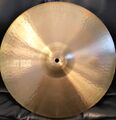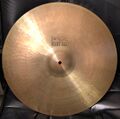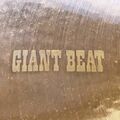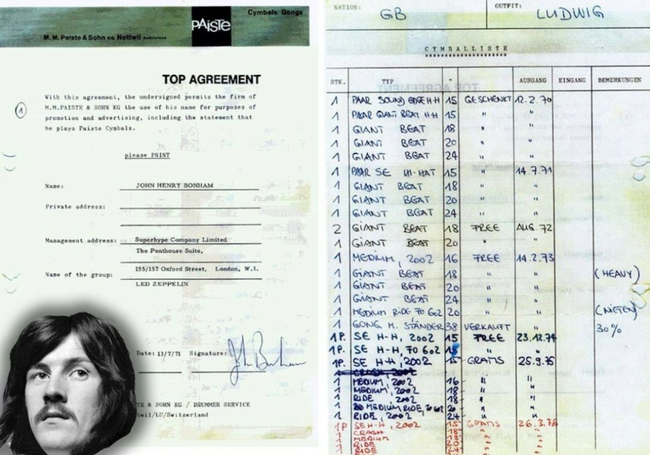Paiste Giant Beat
Giant Beat
Introduction: 1967
Discontinued: 1974
Re-Introduction: 2005
Background: In the late 50’s Paiste experimented with the CuSn8 bronze alloy and pioneered CuSn8 cymbals in 1963 with the "Stambul65" • In the 60’s the electrified sound generated was groundbreaking and popular music, simply stated, became loud and irreverent • CuSn8 bronze that Paiste worked on turned out to be perfect for the new soundscape with its amplified volume and frequencies • 1967 Paiste launched the Giant Beat cymbals, which are characterized by warmth, strength and brilliance drummers had not known before. A resurgence in vintage sounding cymbals was the catalyst in their re-introduction in 2005. Thin Giant Beats were added to the line in 2012.
Innovation: First "fully professional" cymbal series to be manufactured from the popular CuSn8 Bronze, “2002 Bronze” (Stambul65 was the 1st.)
Alloy: CuSn8 (Also known as "2002 Bronze")
Quality: Professional
Production: Manual craftsmanship • Hand hammering, hand lathing • Proprietary manufacturing methods
Applications: Soft to loud settings • Live and recording • Rock, Blues, Rock’n’Roll, Swing, Country, Garage Rock, British Rock and Pop, Beat
Users: Working musicians, enthusiasts • Drummers eager to re-capture Paiste vintage cymbal sounds from the late 60’s
Sound: Bright and warm with a multilayered, full, dark, glassily splendid presence. The following description was posted in the Paiste 1969 catalog:
"Continuing their search for new cymbal sounds and tone colors, the Paiste Development have now turned their attention to the problems and requirements of Beat Group and Big Band drummers.
As the result of extensive consultations between Paiste Technicians and top line drummers in these fields of music, Giant Beat cymbals were evolved.
The obvious problem of the Beat or Big Band drummer is competing with the sound of the amplifiers or a large number of musicians around him - GIANT BEAT CYMBALS provide the answer!
The production of GIANT BEAT is considerably different to the technique normally employed. Each GIANT BEAT cymbal is passed through a unique hardening process to insure it will stand up to the rigors of continuous heavy playing - this process combined with the way in which the cymbals are shaped, hammered and annodised, finally produces a set of cymbals with a sound capable of cutting through the loudest of Groups or Big Band sections.
Although GIANT BEAT cymbals can be purchased individually, they are offered in tuned sets - Matched 15" Hi-hat, 18" Crash and 20" Ride.
GIANT BEAT cymbals with their distinctive SOUND, SHAPE AND COLORING are fast growing in popularity - try them soon you will be impressed."
Rides
Crashes
Hi-Hats
Giant Beat vintage


Introduction: 1967
Discontinued: 1974
Background: In the early 60’s Paiste experimented with the CuSn8 bronze alloy and pioneered CuSn8 cymbals in 1965 with the "Stambul65" • In the 60’s the electrified sound generated was groundbreaking and popular music, simply stated, became loud and irreverent • CuSn8 bronze that Paiste developed turned out to be perfect for the new style of music with its amplified volume and frequencies • 1967 Paiste launched the Giant Beat cymbals, which are characterized by warmth, strength and brilliance drummers had not known before. A resurgence in vintage sounding cymbals was the catalyst in their re-introduction in 2005.
Innovation: Paiste's first professional level series to be made from B8 bronze.
Alloy: CuSn8 (Also known as "2002 Bronze")
Quality: Professional
Production: Manual craftsmanship • Hand hammering, hand lathing • Proprietary manufacturing methods
Applications: Soft to loud settings • Live and recording • Rock, Blues, Rock’n’Roll, Swing, Country, Garage Rock, British Rock and Pop, Beat
Users: Working musicians, enthusiasts • Drummers eager to re-capture Paiste vintage cymbal sounds from the late 60’s
Sound: Bright and warm with a multilayered, full, dark, glassily splendid presence.
Nick Mason playing a full set of "White label" giant beats
Bonham, Sydney 1972 with his "Black label" Giant beats!
Full set of vintage giant beats
The following description was posted in the Paiste 1969 catalog:
"Continuing their search for new cymbal sounds and tone colors, the Paiste Development have now turned their attention to the problems and requirements of Beat Group and Big Band drummers. As the result of extensive consultations between Paiste Technicians and top line drummers in these fields of music, Giant Beat cymbals were evolved. The obvious problem of the Beat or Big Band drummer is competing with the sound of the amplifiers or a large number of musicians around him - GIANT BEAT CYMBALS provide the answer! The production of GIANT BEAT is considerably different to the technique normally employed. Each GIANT BEAT cymbal is passed through a unique hardening process to insure it will stand up to the rigors of continuous heavy playing - this process combined with the way in which the cymbals are shaped, hammered and anodized, finally produces a set of cymbals with a sound capable of cutting through the loudest of Groups or Big Band sections."
The first generation of Giant Beats were printed with white ink at 9:00 O'clock (see picture gallery below) starting in 1967 until early 1972.
The second generation of Giant beats featured Black ink (at 12:00 O'clock) and a slight change to the way they were stamped.
This series was a concept of multipurpose cymbals. Initially, they consisted of three sizes of cymbals and one size of Hi-Hats (15").
*multipurpose
Hi-Hats
From 1972 until 1973 (black labels), expanded lineup:
*multipurpose
Hi-Hats
(*Originally, Paiste did not designate the type of cymbal with the exception of the hi hats (see Paiste profile 1 pictures below), in some advertising they labeled then "crash" or "ride" Ludwig listed the cymbals this way in thier catalogs and not as "multipurpose").
(**The 18" was also listed as a "heavy" in Nick Mason's profile and Bonham's endorsement deal, see pictures below)
Serial numbers
Giant Beats were stamped with serial numbers beginning in 1972 through 1973, any cymbals that were leftovers and sold in 1974 also got serial numbers (4xxxxx).
The numbering system follows the six digit "Swiss standard": first digit of the serial is the year of manufacture i.e. #3xxxxx was made in 1973 (see picture below).
As a rule of thumb: if your Giant beat does not have a serial number, it's definitely a white label.
If the printing is worn off your cymbal, there's two ways to tell the age: the emboss or stamp (early or late version, see above) or if it does or does not have a serial number.
If your Giant beat does have a serial number, it's either a very late run white label or a black label, it's safe to say virtually all black labels had serial numbers!
- Gb 14 serail 1.jpg
1973 serial number
A word about Bonham's use of Giant beats throughout his career: (since he was by far the most famous user of these cymbals, it's important to understand when he used them and on what albums):
It is believed that when Zeppelin went on tour in the U.S. opening for Vanilla fudge (Dec 1968 through early 1969), Carmine Appice introduced him to and possibly loaned him a set of Giant beats (Carmine also helped him get a Ludwig endorsement which could've led to his 1st. use of Paiste's considering Ludwig was the U.S. distributor!).
It is generally agreed that Bonham started using Giant beats full time in Feb. of 1970 (previously, throughout 1969 he was using a set of 602's possibly mixed with Carmine's Giant beats or a set from Ludwig).
Photos show that Bonham was using 15" 602 sound edges very early in 1970, he may have switched back and fourth between Giant beats and 602's, but it looks and sounds like the 602 sound edges were his main hi-hats until the U.S. tour in May of 1973 (then 2002's).
Album/tour usage*:
Led Zeppelin II: Possibly all 602's or a mix of both, this album was recorded while on tour in the U.S in 1969, he could’ve used Carmine's Giant beats that were loaned to him or a set from Ludwig.
Led Zeppelin III (and tour): 18", 20", 24" Giant beats, 15" 602 sound edges
Led Zeppelin IV (and tour): 18", 20", 24", Giant beats 15" 602 sound edges (yes, "Rock and roll" was recorded with 602 sound edges!)
Houses of the Holy: 18", 20", 24", Giant beats 15" 602 sound edges (early part of the 1973 tour shows him using a 16" 2002 on his far left)
The Song remains the same (May 1973 U.S. tour): 18", 20", 15" sound edges, (all 2002's), 24" Giant beat
Physical Graffiti (and tour): 18", 20", 15" sound edges, (all 2002's), 24" Giant beat
(important note: half the songs on Physical Graffiti were leftovers from the three previous albums, you can compare the differences in cymbals by listening to some songs back to back e.g: "night flight" vs. "in the light")
Presence: 16", 18", 24" , 15" sound edges, (all 2002's)
In through the out door: 16", 18", 24" , 15" sound edges, (all 2002's)
As you can see, on half of the Zeppelin albums he used Giant beats and continued to use his 24" on Physical Graffiti and the subsequent tour in 1975.
It wasn't until the last two albums that he used all 2002's with a 20" 602 thrown in for good measure!
(*) This chart is based on data from various sources, we have made our best effort to ensure it's accurate but it cannot be guaranteed 100%
BONHAM'S CYMBALS - THE CRASHES - ANALYSIS AND DEMO
BONHAM'S CYMBALS - THE RIDES - ANALYSIS AND DEMO
BONHAM'S CYMBALS / THE HI-HATS / ANALYSIS AND DEMO
Information from:Paiste catalogs, Todd Little, George Fludas, Dan Garza
Return to the Paiste Series Portal
Return to the Paiste Cymbal Type Portal




















